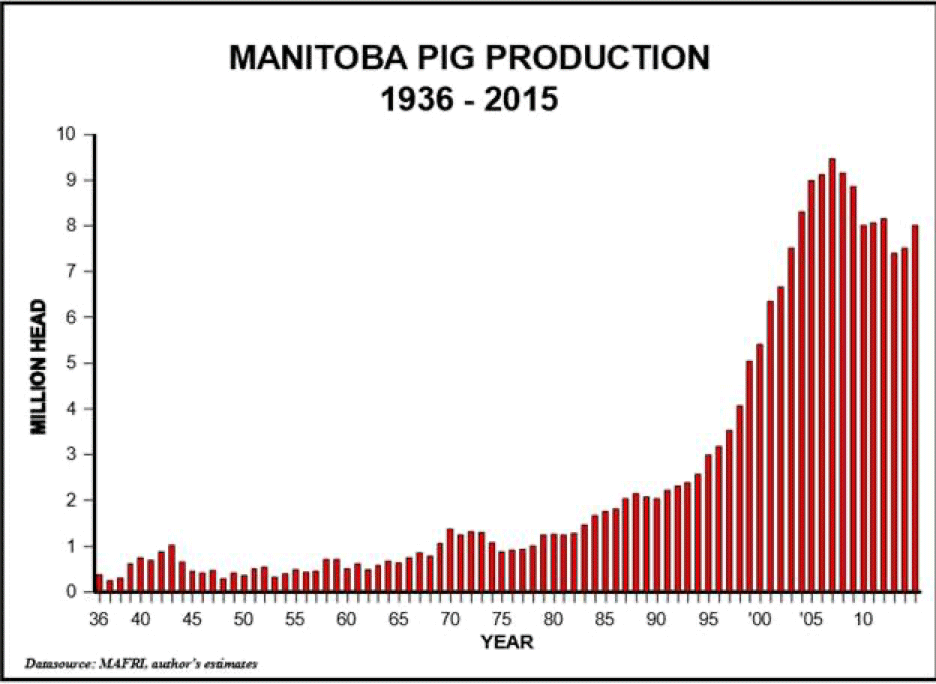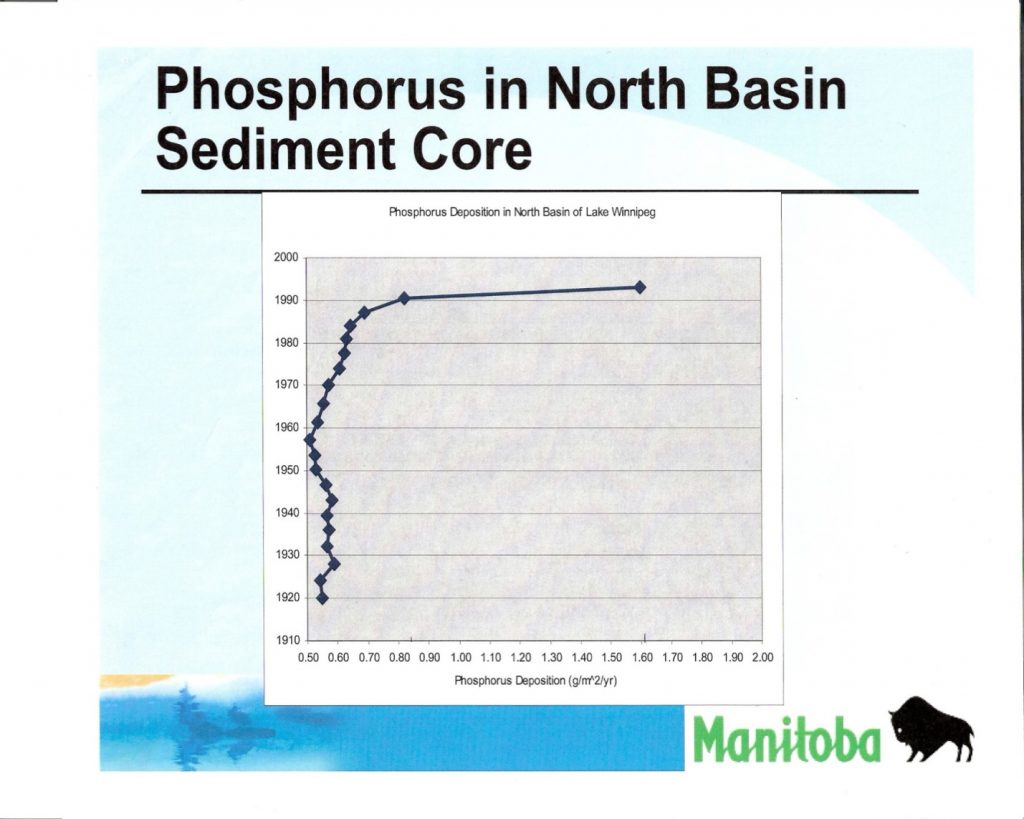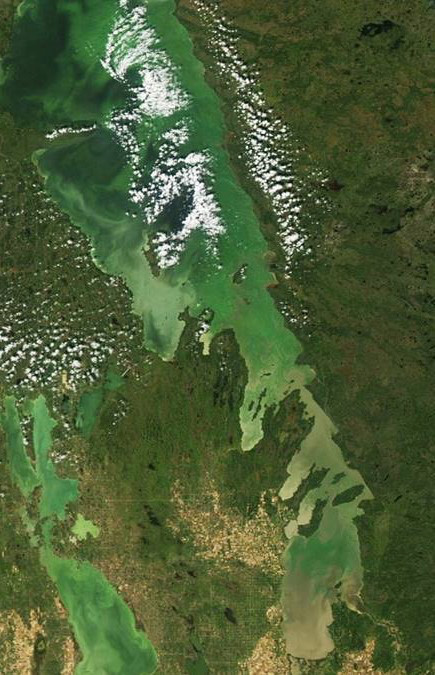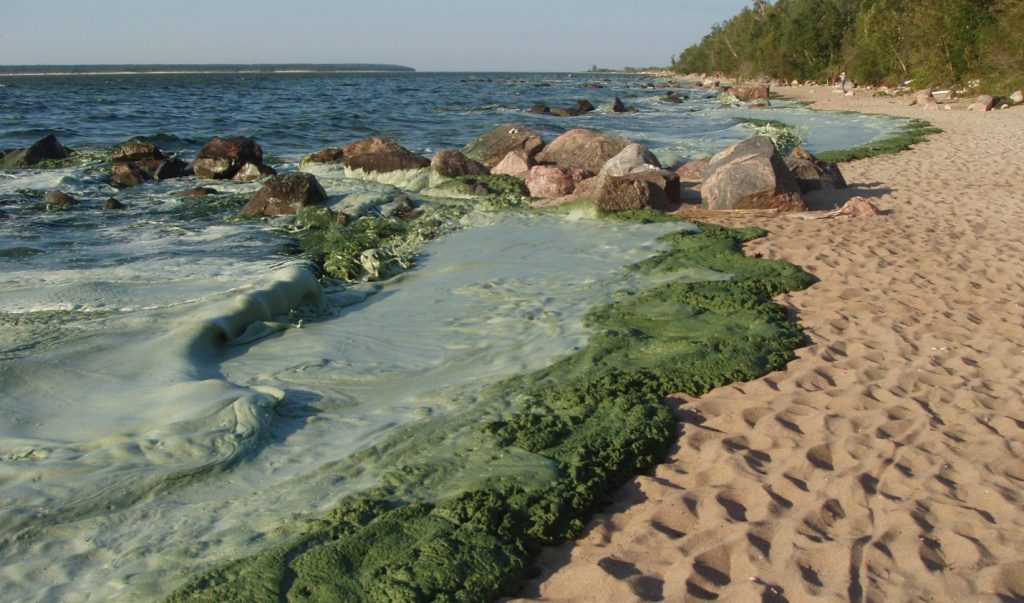Presentation by Vicki Burns to Winnipeg Humane Society on Facebook Live
June 25, 2020
I believe that there is a solid connection between the deteriorating state of Lake Winnipeg due to blue-green algae and the growth in Manitoba’s hog industry in the last 25 years. I do want to stress that the hog industry is not the only contributor to the problem but I believe it is significant enough to warrant serious attention.
First, I will give you a little introduction about me. My name is Vicki Burns, and when I was 12 years old my parents bought a cottage on Lake Winnipeg at Balsam Bay so I have very fond memories of summers spent at the lake with lots of time splashing in the water and hanging out on the beach. That cottage remained in our family for almost 50 years so my attachment to Lake Winnipeg has a long history.
Then in 1994 I started at the Winnipeg Humane Society as Executive Director. Shortly after I started, people began to call me asking if I knew how mother pigs were kept and that was when I began to educate myself about how the animals were kept in the industrial-style barns in Manitoba. As time went on, I began to understand that the intensive confinement of thousands of pigs under one roof created systemic and chronic animal welfare problems and, as well as the suffering of the animals, it led to environmental problems. In order to explain why, I need to give you a snapshot of how the animals are housed.
The pigs are kept indoors in buildings with slatted floors so that their urine and feces fall into pits under the floor. This creates toxic fumes coming up from the pit: hydrogen sulphide, methane and ammonia that would kill the pigs if there weren’t huge fans blowing the air out of the building. Those fumes are so hazardous that there have been instances of farm workers dying because they’ve been overcome by the gases when they have to repair something in the pit. As well, whole barns full of pigs have suffocated to death when the electrical system fails and there is no ventilation. But I digress, lets get back to what happens to the liquefied manure that falls through the slats into a pit beneath the barn.
This waste is flushed out of the barn pits into open lagoons nearby about once a week. Those lagoons are emptied once a year by being spread on or injected into fields as fertilizer.
And here is where the big concern for Lake Winnipeg comes in. The pig manure is a good fertilizer if it is applied in the right amounts at the right time to a crop that can benefit from it. Pig manure contains phosphorus and nitrogen that are both essential elements needed for anything to grow. However, if the manure is applied to soil that already contains a high amount of phosphorus, it will not be taken up by whatever is growing on that field and it becomes available to run off the land during the spring snow melt or during big rain events or floods. It will run into ditches, creeks, rivers and ultimately end up in Lake Winnipeg.
Phosphorus and nitrogen are the two elements that are feeding the blue-green algae blooms that are plaguing the lake. The hog producers need to empty their lagoons to make room for more manure and it is too expensive for them to haul the liquid manure very far, so it will be applied to whatever fields they have arranged to use. Here is some text from the Government of Saskatchewan’s website that describes the challenges of using liquid manure as a fertilizer:
“Manure is not an “off-the-shelf” fertilizer and may not match the crop’s relative requirements. Examples of this would be manures that contain more phosphorus relative to nitrogen than what the crop can use, or an inadequate amount of sulphur relative to nitrogen. As with any fertilizer, over-application of manures (e.g. repeated application at rates which greatly exceed the crop nutrient removal) and improper application increases the risk of manure nutrient losses to the environment and deterioration of environmental quality.”
I am now going to talk about the timelines of the growth in Manitoba’s hog industry and how that coincided with the increasing problems of blue-green algae in Lake Winnipeg. Here is a chart that shows the dramatic climb in the number of pigs raised in Manitoba, starting way back in 1936 when there were a few hundred thousand pigs and rising slowly until about 1995 when the numbers shot up from 2 million per year to 8 million per year in the early 2000’s.

The reason for the dramatic rise in the 90’s was that the Provincial Government did a few things to favour the takeover of hog production by the transnational corporations like Maple Leaf and HyLife. We went from having almost 2,000 hog farmers with a few hundred pigs each to 590 hog farms averaging 5,720 pigs on each farm today. The huge Maple Leaf slaughterhouse was built in Brandon and the government wanted to ensure there were enough pigs to meet the needs of that slaughterhouse.
Here is another graph I want to show you that shows the amount of phosphorus deposited in Lake Winnipeg each year way back to 1920 and up to the mid 90’s.

As you can see from this graph, the amount of phosphorus getting into the lake each year has remained fairly steady from 1920 to 1970 when it started to increase slightly. But from 1990 to the mid-90’s it almost doubled and it is three times as much as was getting into the lake 100 years ago.
Now, you may be wondering what else has changed since the 1990’s that would be contributing to more phosphorus in Lake Winnipeg. It is an important question to ask and there are other factors such as climate change that has caused more flooding, snowstorms, etcetera, resulting in more run-off from the land and an increased human population whose waste also contains phosphorus, which is why we hear about the essential need to upgrade Winnipeg’s sewage treatment. I am certainly not disputing these other factors contributing to the problem of toxic algae in Lake Winnipeg but the impact of the hog industry in Manitoba can be measured and we can get a very evidence-based answer as to how much a part of the problem it is. So why are we not doing that?
I am part of a coalition, Hog Watch Manitoba, that for two years now has been proposing data collection focused on measuring the amount of phosphorus in run-off from manure spread fields. I can describe how this would be done. It would be similar to the Lake Winnipeg Foundation’s Citizen Based Water Monitoring program: trained volunteers or staff would collect water samples in ditches alongside fields, starting at the top of the field and also sampling at the bottom of the field to ascertain differences in phosphorus amounts at prescribed times of the year. Usually this would occur during the spring melt, after any major rain event and periodically during the growing season. Calculations would need to be made about the amount of flow from that particular area. The samples would be analyzed for phosphorus content at an accredited lab and then compared to samples taken from other non-manure spread fields.
We have proposed this idea to the Manitoba Government Agriculture Department; the Agriculture Faculty at the University of Manitoba; the private corporations Maple Leaf and Hylife (the two largest corporations in the hog industry in Manitoba); and to Manitoba Pork – all to no avail. Given that we have often heard the government saying they want to develop policy which is evidence- based, it does seem contradictory that they opt to not collect the evidence to make those evidenced-based policies in this case. Regarding the lack of response from Maple Leaf, Hylife and Manitoba Pork, it makes me suspicious that they simply do not want to gather any data that will dispute their claim that they are not part of Lake Winnipeg’s problem.
Now onto the state of Lake Winnipeg and why it is such a big concern. Since the mid-1990’s, Lake Winnipeg has experienced very significant blue-green algae blooms, many of which contain toxins that are dangerous to humans and animals. Here is a satellite image from NASA in September 2015 showing Lake Winnipeg demonstrating how big the problem can be.

The bright green covering huge areas of both the South basin and North basin of Lake Winnipeg is blue-green algae.
The image below is from Victoria Beach in 2008.

Some people say that we have always had a lot of algae in the lake – which is true – but the composition of that algae has changed dramatically over the past 50 years. It used to be composed of a variety of different species and the blue-green component comprised only about 25% of the total. This has changed now so that the blue-green is closer to 90% to 95% of the total. The problem with this is that the blue-green algae can contain some very dangerous toxins. I will name a few of the common ones: microcystin – which can cause skin rashes, respiratory illness, gastrointestinal illness and liver damage and BMAA which has been linked to motor-neuron diseases like Alzheimer’s, Parkinson’s and ALS.
Our Provincial Government is doing very limited testing for toxins in the algae blooms. Currently, they are only routinely testing for microcystins when there is an algae bloom visible. However, we know that BMAA is present in some of the blue-green algae due to research done by Dr. Eva Pip formerly of the University of Winnipeg and Susan Burch from the University of British Columbia. At this point there is also no routine testing of any bioaccumulation of these toxins in the flesh of fish from the lake.
To sum up, I will reiterate that there are multiple sources of the phosphorus and nitrogen that are feeding blue-green algae in Lake Winnipeg, primarily from human and animal waste and chemical fertilizers. I am not pointing the finger solely at the hog industry but the dramatic increase in the algae since the 1990’s coincides closely to the dramatic increase in the number of pigs raised in Manitoba from 2 million to 8 million. We do have the means to actually measure how much phosphorus and nitrogen is getting into the lake from hog manure on fields so why are we not doing that?
I think the health of Lake Winnipeg and all the humans and animals that depend on it are definitely worth the investment of getting the facts on the hog industry’s contribution to the problem.
